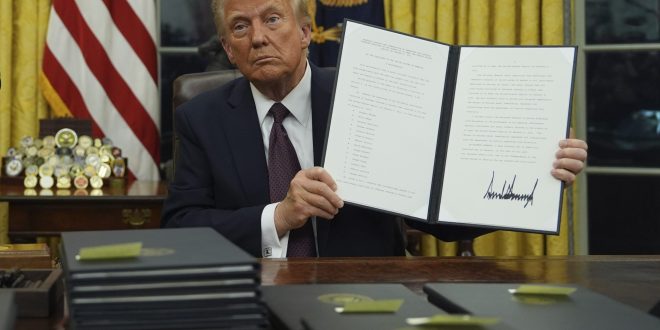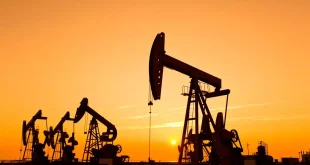President Donald Trump has promised to drastically lower oil prices in the United States during his second term—but the world’s oil-producing states may not allow him.
U.S. President Donald Trump’s ambitious plan to revitalize the American oil sector and slash prices, a key promise of his reelection campaign, may be in jeopardy. During the 2024 election campaign, Trump repeatedly vowed to “drill, baby, drill”—to boost domestic oil production, fortify the American energy sector, and diminish the United States’ reliance on foreign imports. However, Trump’s strategy is incompatible with several realities of the global energy market. These include the worldwide transition to cleaner and renewable energy sources; fluctuations in the price of oil; and disruptions in the global hydrocarbon supply chain. Any attempt to surge oil production is further complicated by geopolitical tensions and escalating environmental concerns. These factors will have significant ramifications for U.S. energy security, economic growth, and international relations throughout Trump’s second term.
Remaking U.S. Energy Policy
During the election cycle, Trump was somewhat cagey about his agenda. Beyond “drill, baby, drill,” the President has offered little in the way of concrete policy on how to accomplish increased oil output. However, observers can look to his allies’ plans for how he might achieve this. “Project 2025,” a guidebook for the next Republican administration written by the conservative Heritage Foundation think tank—including Russ Vought, Trump’s pick for the Office of Management and Budget—provides one such plan.
Project 2025 seeks to drastically boost oil and gas output through aggressive deregulation of the fossil fuel industry. For instance, the plan calls for eliminating clean energy tax incentives, tearing down public health and climate protections, and undermining the Environmental Protection Agency’s regulatory authority, giving it less power to challenge hydrocarbon projects it believes would hurt the environment.
Despite these lofty promises, the state of global energy markets and changing commodities dynamics threaten to derail Trump’s domestic reforms. Although low prices are a stated aim of Trump’s policy, they might also jeopardize American producers’ profitability in an oversupplied market, making it more difficult for companies to strike a balance between raising output and preserving stable price levels. Furthermore, a global oil glut would disincentivize exports, as U.S. producers struggle to locate foreign consumers willing to pay top dollar for American crude.
Equally as important, Trump’s agenda will almost certainly face legal and procedural obstacles. American energy regulations are so byzantine that any attempt to remove them in one stroke—a step that Trump has promised—would necessarily invite lawsuits. Finally, given its potential for long-term sustainability, job creation, and economic growth, private industries that have flourished under the Biden administration will pressure the incoming president to incorporate clean energy into his government’s policy framework, which Trump has previously rejected. To resolve these competing demands, the incoming president’s energy policy will need to be flexible and savvy.
Trump’s target of lowering gasoline prices to less than $2 per gallon is not realistically attainable. Significant price cuts will be constrained by external market dynamics and production capacity. Additionally, U.S. states that have made significant commitments to renewable energy may oppose Trump’s fossil fuel policy, escalating tensions between the federal and state governments.
Facing International Headwinds
Of course, foreign factors may influence Trump’s energy strategy more than domestic hurdles. Global oversupply, according to analysts, could drive down prices and make it more difficult to boost domestic output. According to some estimates, crude prices could decline from $80 per barrel in 2024 to $74 per barrel in 2025—and may even fall as low as $65. If non-OPEC+ producers, including the United States, increase their output by 1.4 million barrels per day (BPD) as expected, prices could drop even further.
Trump may succeed in increasing supply while maintaining profitability for American oil companies if OPEC+ implements further production cuts to stabilize prices. However, the world’s major oil producers are unlikely to undercut their own revenues to placate the president—especially with weakening global demand due to declining consumption in China.. To make matters worse for other oil-producing states, imports in the United States could drop by more than 20 percent to 1.9 million barrels per day, the lowest level since 1971, as U.S. crude production increases.
Interestingly, the Trump administration may bolster its own strategy by reinstating strict economic sanctions against Iran. Over a million barrels per day of Iranian crude might be taken out of the world’s supply if Washington returns to the “maximum pressure” campaign of the first Trump administration, which could drive up prices and enhance profits. These calculations demonstrate the intricacy of the world’s hydrocarbon markets and the difficulty of securing U.S. economic interests amid such dynamic forces.
National Energy Emergency
The declaration of a “national energy emergency” by President Donald Trump on January 21, 2025, marks a dramatic change in U.S. energy policy. The administration attributes the emergency order to inadequate energy production, transportation, refining, and generation capacity in the United States. The administration will also likely speed up energy projects and production by reducing environmental rules and streamlining permitting procedures. As a consequence of this order, the United States might lessen its need on foreign energy supplies by giving priority to expanded home production of gas and oil, and increase energy independence.
Depending on how the strategy is carried out and how it impacts the dynamics of the global oil supply and demand, more local output may result in reduced oil prices. The action may also have an impact on the dynamics of the world market, especially about OPEC+ choices.
Trump’s pro-fossil fuel stance also flies in the face of the global movement away from fossil fuels. The administration may become more and more isolated in international energy markets despite the proclamation of a “national energy emergency.” International market dynamics, especially the strong momentum toward renewable energy and electric vehicles in regions such as Europe, could jeopardize the declaration’s goals of increasing domestic oil and gas output and lowering regulatory hurdles. It will take a careful balancing act to keep America competitive.In the end, U.S. domestic energy policies cannot unilaterally control global market dynamics or oil prices. International trends, technology advancements, and climate concerns are all influencing the global energy environment more and more. The Trump administration’s approach might be up against a strong global energy transition trend. The best course of action would be to acknowledge how intertwined the world energy market is and to adjust to the constant changes in the environment and technology rather than fight them. If this isn’t done, American energy interests could be marginalized in a world that is changing quickly.





